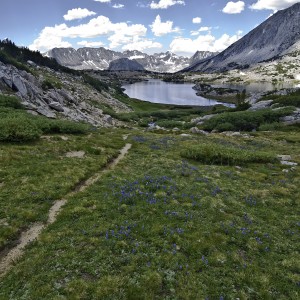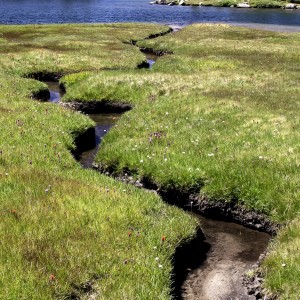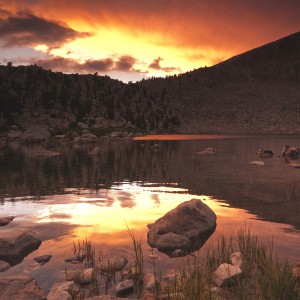
My son Danny and I have gone on backpacking trips in the Eastern Sierra every summer since he was seven years old. He is now thirty-two, which means that we have had a little time to explore a lot of the backcountry, from Lone Pine north to the Sonora Pass. These trips have taken us to some of the most spectacular mountain areas in the world. The trailheads to each of these hikes are a short drive from Mammoth.
While we love the backcountry, after a few nights we are already looking forward to a good shower and nice bed, and talking about which restaurant we will go to when we get back to Mammoth for some “real” food. We have learned is that you can see this spectacular scenery without spending weeks sleeping on the ground and eating freeze dried food.
In order to get to these great backcountry locations, we have found that you need to hike far enough, and probably over at least one steep mountain pass, to get away from the day hikers, the little kids and the fished-out lakes. Once the barrier of the steep pass is crossed, we have found the “real” backcountry – with lakes where you can actually catch your dinner, fields of wildflowers, and where neighboring campers and hikers are few and far between.
Once we get over the pass to the backcountry, we often set up camp and stay for a few nights. That lets us enjoy what is most often the highlight of our trip – the backcountry day hike. With no heavy backpack slowing us down, and no steep pass to traverse, we can comfortably climb to less accessible areas, cover a lot more ground, and spend hours walking around knowing that our camp is already set up and easy to reach.
With the freedom to hike easily from a backcountry base camp, we have roamed far and wide. Every time we have taken one of these backcountry day hikes, we have found something that takes our breath away. Sometimes it is an entire hillside covered with wildflowers and small streams. Or, topping a steep hike up a hillside, we have been confronted with a wide-open desolate and boulder strewn valley with a lake that looks like it has never once been visited before.
It will take one fairly strenuous day, or two easier days, to get to these magnificent backcountry locations. But even if it takes two days to hike in, it usually only takes one day to hike out since most hikes begin with steep ascents up the eastern slopes of the Sierras and end with trails heading primarily downhill. That will leave a full day and night to spend in the backcountry on a beautiful backcountry day hike.
These are some of our favorite backcountry day hikes.
PIONEER BASIN
The first part of this hike is one of the most popular in the Eastern Sierra since the trail head at the Mosquito Flat Trailhead begins at a high altitude (10,300 feet), does not gain a lot of elevation, and travels through beautiful, lake-dotted areas. But for all of these reasons, this part of the trail is often very crowded. But most day hikers will have to turn around before the Mono Pass Trail steeply ascends the side of Mt. Starr to Mono Pass (12,060 feet) before descending into Pioneer Basin. Once over that pass, the backcountry opens up.
On our trip, we passed the lowest and largest of the Pioneer Basin lakes and climbed to Lake 11026 where we set up a camp next to a beautiful alpine lake. The next day, we grabbed our day packs and explored the Pioneer Basin, scrambling up wildflower strewn creeks that tumbled from the Basin’s higher lakes.
It would also be possible to day hike to spectacular Fourth Recess Lake. Instead, we visited that area on the trip back and spent another night at this large backcountry lake, listening the roaring of the waterfall that drops into the lake on its southern shore.
HUMPHREY BASIN
Humphrey Basin is 7 miles – and one steep Sierra Pass (Piute Pass, elev. 11,423) – from the trailhead at North Lake. Once you are at Humphrey Basin, you can choose campsites at any one of numerous beautiful locations. We love aptly named Desolation Lake, where it takes a little while to find the secluded campsites among the giant white boulders that cover the area.
We had one of our most spectacular day hikes from Humphrey Basin to Hutchison Meadow. Although the often flower-covered Meadow was dry that year, the cross-country scramble to get there led us through some of the most spectacular displays of wildflowers we have seen.
RAM LAKE AND VIRGINIA LAKE
The Duck Pass Trailhead begins at Lake Mary in the Mammoth Lakes area and is a beautiful – and crowded – day hiking area. But once you get over Duck Pass (elev. 10,800) itself and get to Purple Lake, you will have left most of the day hikers behind. You can stop there and hike up to Ram Lake or further along the trail to Virginia Lake.
After spending the night at Purple Lake, we decided to carry our back packs up the short, but steep, hike to Ram Lake , past gorgeous fields of yellow wildflowers, with panoramic views of the Sierra range to our west. Ram Lake is a beautiful, secluded backcountry lake.
Our “day hike” here from Ram Lake to Lake Virginia actually was accompanied by our back packs, but was short and primarily level. This secluded, cross country hike was through backcountry dotted with lakes and crossed by small streams cutting through flower covered meadows. It was pretty enough that we didn’t mind the backpacks at all!!
COTTONWOOD LAKES LOOP AND MT. LANGLEY
A few beautiful days of hiking brings you to one of the highest day hikes of them all – to the 14,042 foot summit of Mt. Langley.
The trail to Mt. Langley angles off from the Cottonwood Lakes Loop trail. And while the summit of Mt. Langley is certainly a high point of the trip in every respect, the rest of the trip isn’t so bad either.
The trail head for this hike begins 23 driving miles from Lone Pine at Horseshoe Meadows (elev. 10,000). If you choose to go clockwise, you would first find yourself at beautiful Chicken Spring Lake and then perhaps at secluded Soldier Lake. A short steep hike will bring you to the cut off to Mt. Langley, a Class I trail to one of the highest peaks in North America and an incredible view of Mt. Whitney to the North and the Owens Valley 10,000 feet below. The trip back down New Army Pass (recommended over the steep, narrow and non-maintained Old Army Pass) takes you to the beautiful Cottonwood Lakes, home of the Golden Trout.










